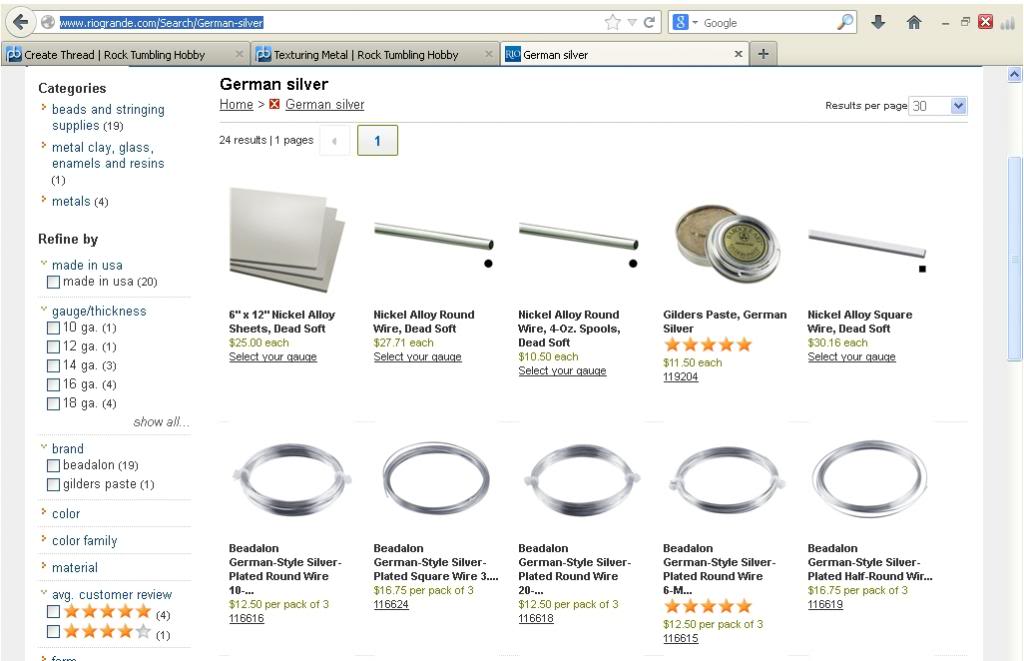|
|
Post by 1dave on Nov 25, 2013 7:50:12 GMT -5
Cu 60%, Ni 20%, Zn 20% - also in other alloys that melt at lower temperatures, but usually around 1450 oC, 2642 oF. It contains NO silver, and is very difficult to cast. It is often used in jewelry because it is inexpensive, looks good, is the same color as solder, and even bezels are nearly impossible to be melted and ruined by beginners. www.riogrande.com/Search/German-silver With a little begging, I believe jamesp could beat these prices ?? I prefer the term "White Brass" because I feel the other two, although most often used, are misleading.
|
|
|
|
Post by 1dave on Nov 25, 2013 7:52:19 GMT -5
RE: German Silver ----> jamesp - Is this the stuff?? -> 60% copper 20% nickel 20% zinc? Similar to today's nickels 75% copper 25% nickel -------------------- That's a hole pile of fun there! |
|
|
|
Post by 1dave on Nov 25, 2013 7:53:47 GMT -5
I think so Scott. The only german silver i ever worked with came out of those german trays. I learned on that material because it would rarely crack w/abuse(excessive hammering/stretching). They were so heavily silver plated. You can tell a lot about the quality of old silver plate by the thickness of the plating of course. Of the 8 german trays, two of them were a good bit harder to hammer form. They had the designation 18 8. Which is old for 301, and 18 10 is old for 316. Check it out: "The 18/8 and 18/10 designations are older terms, and refer to the amount of chromium and nickel alloyed with the iron, to comprise the stainless steel. The 18/8 name has been pretty much replaced, in the States at least, by several other designations. 301 stainless steel has 16-18% Cr, and 6-8% Ni 302 stainless steel has 17-19% Cr, and 8-10% Ni 304 stainless steel has 18-20% Cr, and 8-10.5% Ni. That may explain your difficulty in finding information on these alloys. Similarly, 18/10 is usually referred to as 316 stainless steel, with 16-18% Cr, 10-14% Ni, and also 2-3% molybdenum, which greatly increases the resistance to pitting corrosion in seawater. Good stuff, that moly." And a flat ware maker has this to say about 18 10 and 18 8: "The difference is in the corrosion resistance (which I assume you're not interested in, since all will be fine for flatware) and in the ductility. A lower alloyed 301 has more ductility when work hardened than the higher alloyed 316. So after you stamp out your quarter hard sheet into forks, you can bend one of the tines more often, or farther, if it is of 301 rather than if it is made of 304 or 316, before it will crack." Making the 18 8/301 friendlier on the anvil. |
|
jamesp
Cave Dweller 
Member since October 2012
Posts: 36,471
|
Post by jamesp on Nov 25, 2013 9:03:42 GMT -5
I am a true hack Dave. I have no experience other than industrial. I am around a lot of talented jewelers but insist on not letting them teach me anything so i can come up with my own perversion.
I hold my own competitively in a couple of tiny urban retail spaces. They used to roll their eyes at my creations until the clients were intrigued. Now i am being copied a bit.Ha Ha
I may buy a new load of scrap and often have to adjust to softer or brittle or richer colored stock. Cookie cutter repetitive stock material can limit your flexibility.
Have gotten away from metal work for couple of years.
|
|
|
|
Post by 1dave on Nov 25, 2013 9:18:45 GMT -5
"True Hacks" are where all the new ideas come from!
NOT the "know it all's."
|
|
jamesp
Cave Dweller 
Member since October 2012
Posts: 36,471
|
Post by jamesp on Nov 26, 2013 10:37:58 GMT -5
Jewelry is especially fun to put out in the public eyes. You never know what is going to be sought after. Us humans are an interesting creed.
|
|